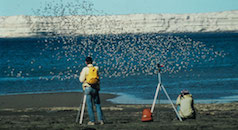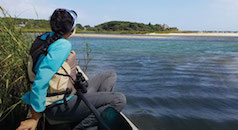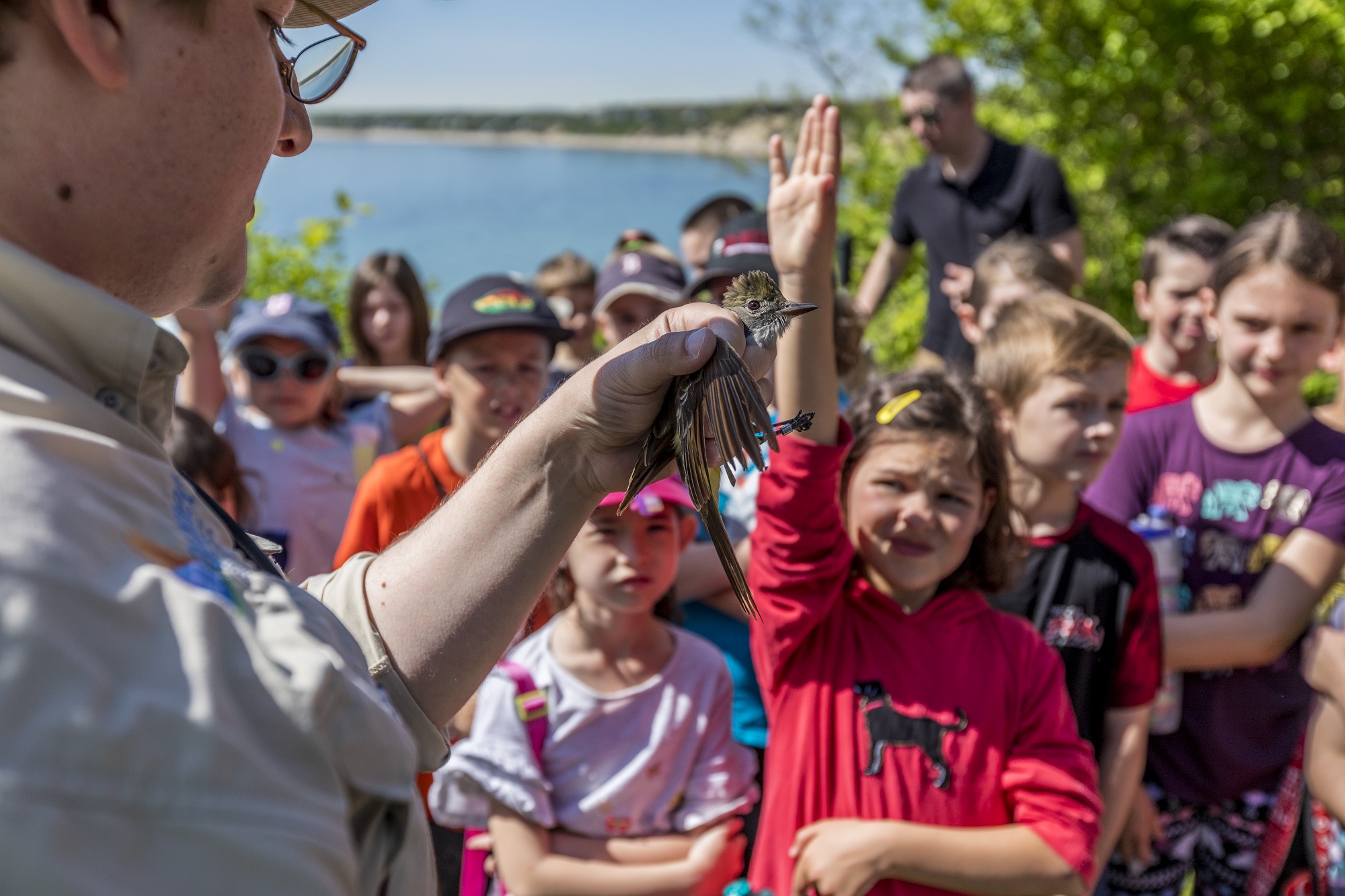Search Results

Manomet Conservation Success Highlighted in 2014 State of the Birds Report
According to the 2014 State of the Birds report, over half of North American shorebird populations are imperiled. Despite this grim outlook, the authors of the report declared that “conservation works” and highlighted the recovery of the American Oystercatcher to illustrate this claim. While many shorebird populations are declining, the American Oystercatcher population in the United States has increased by 10 percent since 2009. The report attributes the strong recovery of the species to the first-ever Business Plan for Conservation that was launched in 2009 by Manomet and the U.S. Fish and Wildlife Service. Shiloh Schulte, the coordinator of the Oystercatcher Recovery Campaign, said that “this conservation story is all the more impressive because the species was...
Boston Globe: In Manomet, a focus on shorebirds’ plight
This article was originally published in the Boston Globe on September 04, 2014 and was written by Jaclyn Reiss. View the original article here. As the population of coastal birds declines both worldwide and in Massachusetts, a conservation group in Plymouth will lead a day-long event celebrating the migratory birds and discussing ways to help stabilize their numbers. The Manomet Center for Conservation Sciences will join various countries to mark the inaugural World Shorebirds Day on Sept. 6, which seeks to raise awareness on the plight of the world’s endangered migratory birds. “There are over 200 species around the world, and 60 to 70 percent of them have been showing major declines in recent decades,” said Brad Winn, director of shorebird...
World Shorebirds Day Celebration Set For Sept. 6
Manomet will host a celebration of the first annual World Shorebirds Day on Sept. 6, including morning birding outings and an afternoon event at the headquarters campus. "It is very encouraging to see the energy and interest growing for World Shorebirds Day,” said Brad Winn, director of Manomet’s Shorebird Habitat Management project. “We will be scanning the coastal wetlands in eastern Massachusetts on the same day as others all over the world are counting shorebirds too. This is global recognition for a group of birds showing population declines in every flyway. Recognition and appreciation are the first steps in conservation." The global celebration was proposed and organized by György Szimuly, a well-known bird conservationist based in Milton Keynes,...
First Ever Geolocator Results for a Semipalmated Sandpiper Show Remarkable Year-long Odyssey
Data that Manomet scientists recovered from a Semipalmated Sandpiper on sub-Arctic Coats Island in June revealed that the bird flew a total distance of over 10,000 miles in the past year, including a remarkable six day, 3,300-mile nonstop flight across the Atlantic Ocean. The shorebird was equipped with a geolocator by a Manomet research team in 2013 as part of a first time effort to use the devices to understand the migration of Semipalmated Sandpipers. Manomet researchers Brad Winn and Shiloh Schulte returned from eastern Canada’s Coats Island last week with the first two geolocators for the Semipalmated Sandpiper migration study, which was designed to solve one of the most pressing mysteries in shorebird conservation. “Surveys conducted...
Arctic Researchers Race to Recover Geotagged Semipalmated Sandpipers
Earlier this month, two Manomet research teams left for field sites in the Arctic to conduct shorebird demographics research and try to recover geolocators placed on Semipalmated Sandpipers last year. Manomet researchers are conducting field work at two sites: Coats Island in Canada’s Hudson Bay, which is the largest uninhabited island south of the Arctic Circle in the Western Hemisphere, and the Canning River in the Arctic National Wildlife Refuge. Many long-distance migrant shorebird species return to the same areas to breed each year, making the birds’ Arctic breeding grounds the only place to reliably study individuals from year to year. The Semipalmated Sandpiper — a small shorebird that breeds in the Arctic and winters in northeastern...
Schulte Visits NYC Sites to Prepare for Oystercatcher Field Research Season
In early May, Manomet’s American Oystercatcher Recovery Project Coordinator Shiloh Schulte visited field sites in the New York City area to meet with partners, discuss plans for this year’s field research season, train field staff, and band oystercatchers. The partners were members of the American Oystercatcher Working Group, which develops, supports, and implements range-wide research and management efforts. “Manomet and NYC Audubon are working with the National Park Service and NYC Parks to promote and coordinate oystercatcher management, monitoring, and research in the New York City area,” Schulte said. During his visit, Schulte assisted oystercatcher banding efforts at Gateway National Recreation Area on Staten Island and at the Arverne beaches in Queens, which is a NYC Parks...
USFWS Reopens Comment Period on Proposal to Protect Red Knot
In early April the U.S. Fish and Wildlife Service (USFWS) reopened the public comment period on its proposal to list the rufa Red Knot as threatened under the Endangered Species Act (ESA). In some areas, Red Knot populations have decreased by about 75 percent since the 1980s, with the steepest declines occurring after 2000. Manomet works with regional, national and international partners to assess threats to rufa Red Knot populations, collect and publish data, and outline metrics for recovery. “The Red Knot has been a focal species of Manomet’s shorebird research since the 1980s, when Manomet Biologist Brian Harrington first brought its migration story to the public eye,” said Brad Winn, Manomet’s director of shorebird habitat management....
Maine Smelt Fry Celebrates Local Heritage and a Sustainable Fishery
The Rainbow Smelt (Osmerus mordax) is a small, sea-run fish that lives in estuaries and saltwater bays and spawns in freshwater streams in spring. Once common from Delaware to Canada, their populations have declined dramatically in recent decades. In 2004, Rainbow Smelt was listed as a federal species of concern. The reasons for these declines are not well understood, but dams, pollution, increasing water temperatures, and overfishing are among possible causes. Similar declines have occurred in parts of Maine, which has led the Maine Department of Marine Resources to ban smelt fishing this spring in the lower half of the state, from Stonington to Kittery. Runs of Rainbow Smelt in the closure area have declined by 50 percent in...
Manomet Scientists Warn of Oil Spill Danger to Nesting Shorebirds
Experts from the Manomet Center for Conservation Sciences warned today about the potential impact of a weekend oil spill in Texas on nesting migratory shorebirds. According to the U.S. Coast Guard, a collision between a barge and a ship near Galveston Bay caused approximately 168,000 gallons of oil to spill into the water. “There is no good time for an oil spill, but this is a particularly bad time because resident shorebirds like oystercatchers are already nesting, and migratory shorebirds are currently using Galveston Bay during northward migration,” said Manomet scientist Shiloh Schulte, who also serves as the coordinator of the American Oystercatcher Working Group. “Galveston Bay has the highest concentration of nesting American Oystercatchers in Texas.” ...
Experts identify Maine wildlife, plants vulnerable to climate change
This article was originally published in the Bangor Daily News on March 12, 2014 and was written by Aislinn Sarnacki. View the original article here. Hard times may be ahead for Maine’s moose, loons and salmon, according to a recent assessment released by the Manomet Center for Conservation Sciences. These iconic Maine animals are just a few of the many species predicted to run into challenges due to climate change. “The Maine of tomorrow will not be the Maine I grew up with,” said Andrew Whitman, director of the Sustainable Economies Initiative at Manomet and one of the seven authors of the assessment. “Species that are common to see may very well not be.” Climate change greatly increases the vulnerability of...



